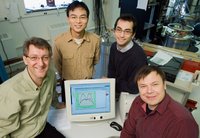Now, researchers at the University of Illinois at Urbana-Champaign not only have discovered an unusual phenomenon in which ultra-narrow wires show enhanced superconductivity when exposed to strong magnetic fields, they also have developed a theory to explain it.
Magnetic fields are generally observed to suppress a material’s ability to exhibit superconductivity – the ability of materials to carry electrical current without any resistance at low enough temperatures. Deviations from this convention have been observed, but there is no commonly accepted explanation for these exceptions, although several ideas have been proposed.
As reported in the Sept. 29 issue of Physical Review Letters, U. of I. physics professor Alexey Bezryadin (pronounced BEZ-ree-ah-dun) and his research group have studied the effect of applying a magnetic field to ultra-narrow superconducting wires only a few hundred atoms across, and have used a microscopic theory proposed by physics professor Paul Goldbart and his team to explain the results.
"My group discovered that magnetic fields can enhance the critical current in superconducting wires with very small diameters,” Bezryadin said. “We spoke with many colleagues and reached the consensus that this phenomenon is indeed curious.”
Magnetic fields have long been known to suppress superconductivity by raising the kinetic energy of the electrons and by influencing the electron spins. Magnetic atoms, if present in the wires, also inhibit superconductivity.
Nevertheless, as reported in the Sept. 15 issue of Europhysics Letters, Goldbart, postdoctoral researcher Tzu-Chieh Wei and graduate student David Pekker proposed that the enhancement observed by Bezyradin’s group was due to magnetic moments in the wires.
“Even though the two effects – magnetic fields and magnetic moments – work separately to diminish superconductivity, together one effect weakens the other, leading to an enhancement of the superconducting properties, at least until very large fields are applied,” Goldbart said.
As for the origin of these magnetic moments, the collaborating groups proposed that exposure of the wires to oxygen in the atmosphere causes magnetic moments to form on the wire surfaces. On their own, the moments weaken the superconductivity, but the magnetic field inhibits their ability to do this. This effect shows up in ultra-narrow wires because so many of their atoms lie near the surface, where the magnetic moments form.
With postdoctoral research associate Andrey Rogachev (now a physics professor at the University of Utah) and graduate student Anthony Bollinger, Bezryadin deposited either niobium or an alloy of molybdenum and germanium onto carbon nanotubes to fabricate wires that were less than 10 nanometers wide. The superconductivity of these wires under a range of applied magnetic fields was examined, and the experimental results were compared with the proposed theory, revealing an excellent correlation between the two.
"The results of this work may provide a key to explaining our previous findings that nanowires undergo an abrupt transition from superconductor to insulator as they get smaller,” said Bezryadin, referring to work published in the Sept. 27 issue of Europhysics Letters.
The work was funded by the U.S. Department of Energy and the National Science Foundation.
Editor’s note: To reach Alexey Bezryadin, call 217-333-9580; e-mail: bezryadi@uiuc.edu.To reach Paul Goldbart, call 217-333-1195; e-mail: goldbart@uiuc.edu.
Contact: Kristen Aramthanapon aramthan@uiuc.edu 217-244-8780 University of Illinois at Urbana-Champaign















No comments:
Post a Comment